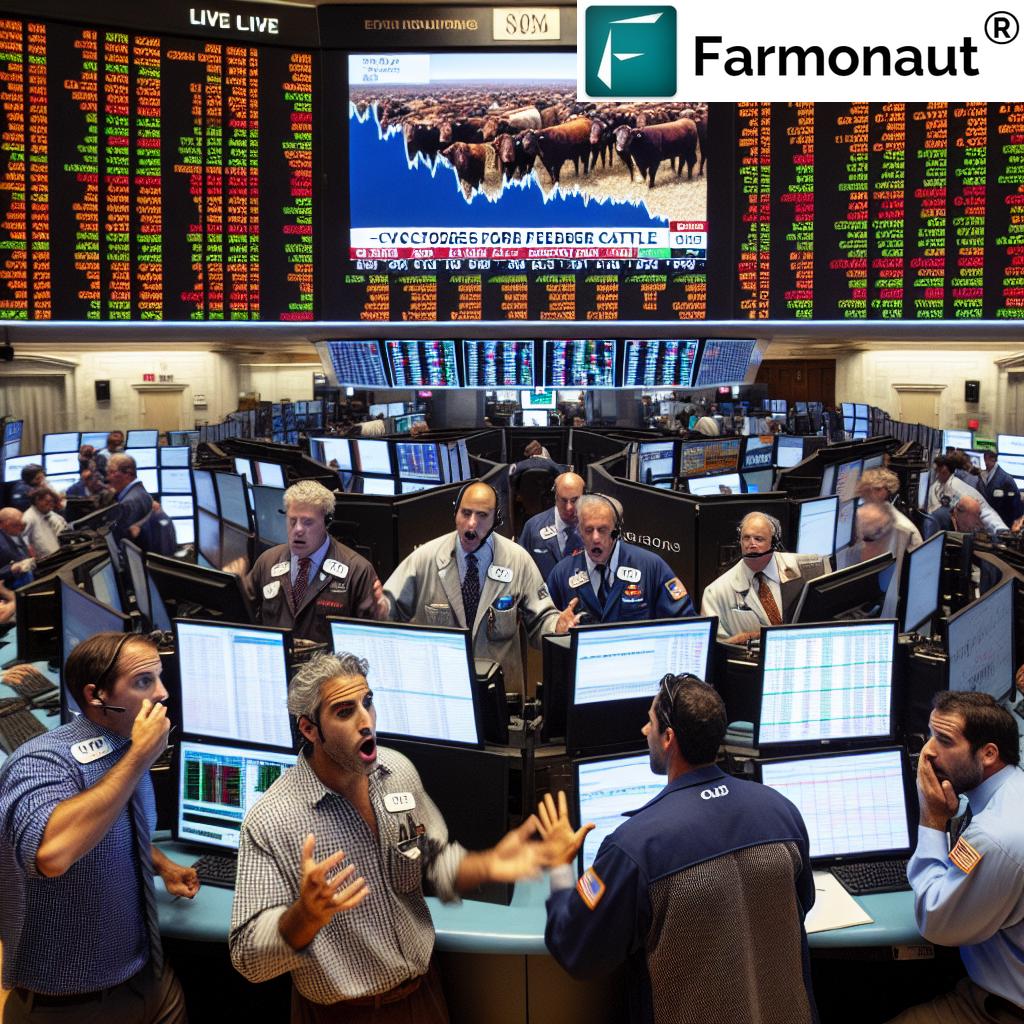Shocking E. Coli Outbreak Sparks Cattle Futures Surge: Unveiling the Beef Industry’s Explosive Demand and Price Hikes
CHICAGO, October 22 (Reuters) – The beef industry is experiencing unprecedented turmoil as a shocking E. Coli outbreak linked to McDonald’s Quarter Pounder burgers coincides with a surge in CME cattle futures. This perfect storm of events has led to explosive demand and significant price hikes across the sector, leaving industry experts and consumers alike grappling with the implications.

CME Cattle Futures Surge Amid E. Coli Concerns
The Chicago Mercantile Exchange (CME) witnessed a remarkable uptick in cattle futures on Tuesday, driven by indicators of heightened demand from both U.S. consumers and exporters. This surge comes at a time when the industry is reeling from a severe E. Coli outbreak that has already claimed one life and sickened 49 others.
- December live cattle futures closed up 1.300 cents at 188.125 cents per pound
- November feeder cattle futures settled 2.325 cents higher at 248.925 cents per pound
- Lean hog futures also saw gains, with December contracts rising 0.85 cent to 79.125 cents per pound
Dennis Smith, an analyst at Archer Financial Services, expressed bewilderment at the market’s resilience: “The strong demand for beef at these price levels is something I just don’t understand.”
Wholesale Beef Prices Hit Record Highs
The beef industry price hikes have been nothing short of staggering. Wholesale beef prices continue to hover at record highs, yet consumer demand remains robust. The USDA reported that the choice boxed beef cutout rose $1.10 to $323.96 per hundredweight on Tuesday afternoon, while select boxed beef prices saw a slight decrease of $1.41 to $294.80 per cwt.
This pricing phenomenon has led to favorable meatpacker margins, as slower slaughter rates and heavier cattle have forced end users to pay premium prices for beef products.
The McDonald’s Quarter Pounder E. Coli Crisis
The E. Coli outbreak beef industry crisis took a dramatic turn when it was linked to McDonald’s Quarter Pounder burgers. The fast-food giant has taken swift action, removing fresh beef patties and onions used for quarter pounders from stores in affected states. This proactive measure was communicated to the Centers for Disease Control and Prevention (CDC) in an effort to contain the outbreak.
Industry experts are closely monitoring the situation, with some traders speculating that the news could put pressure on cattle futures in the coming days due to potential concerns about beef demand.

Cattle Futures Demand Increase: A Paradoxical Trend
Despite the E. Coli outbreak, the cattle futures demand increase has been paradoxical. Several factors contribute to this unexpected trend:
- Economic Resilience: Recent economic data has shown cooling inflation and solid job numbers, indicating a relatively strong U.S. economy.
- Consumer Behavior: Americans continue to demonstrate a willingness to pay premium prices for beef at grocery stores.
- Supply Chain Dynamics: Slower slaughter rates and heavier cattle have created a supply bottleneck, driving up prices.
- Export Demand: Increased interest from international buyers has further tightened domestic supply.
These factors have collectively contributed to the CME cattle futures surge, defying expectations in the face of food safety concerns.
Explore Farmonaut’s Satellite API for Agricultural Insights
Meatpacker Margins and Cattle Futures: A Delicate Balance
The relationship between meatpacker margins and cattle futures is complex and currently favors processors. With wholesale beef prices at record highs and consumer demand remaining strong, meatpackers are enjoying healthy profit margins. However, this situation has created challenges for ranchers and feedlot operators who are facing higher input costs.
Industry analysts are closely watching how this dynamic will play out in the coming weeks, especially in light of the E. Coli outbreak. The ability of meatpackers to maintain these margins while addressing food safety concerns will be crucial for the stability of the beef market.
Access Farmonaut’s API Developer Docs for Advanced Agricultural Data
The Ripple Effect on Related Markets
The turmoil in the beef industry has had a cascading effect on related markets:
- Lean Hog Futures: With attention focused on beef, pork producers are seeing increased demand and higher prices for their products.
- Grain Markets: The surge in cattle futures has implications for feed costs, potentially impacting corn and soybean prices.
- Restaurant Sector: Fast-food chains and steakhouses may face challenges in maintaining profit margins as beef prices soar.
These interconnected market dynamics underscore the far-reaching impact of the current situation in the beef industry.
Looking Ahead: Navigating Uncertainty in the Beef Market
As the industry grapples with the dual challenges of an E. Coli outbreak and surging futures prices, several key questions emerge:
- How will consumer confidence in beef products be affected in the long term?
- Can the current high prices be sustained, or will we see a market correction?
- What regulatory changes might be implemented to prevent future outbreaks?
- How will international trade in beef be impacted by these domestic issues?
The answers to these questions will shape the trajectory of the beef industry in the coming months and years.
Conclusion: A Watershed Moment for the Beef Industry
The convergence of a shocking E. Coli outbreak and a surge in CME cattle futures marks a critical juncture for the beef industry. As consumers, regulators, and market participants navigate this complex landscape, the resilience and adaptability of the sector will be put to the test.
While the immediate focus remains on containing the E. Coli outbreak and managing market volatility, the long-term implications of these events will likely reshape the beef industry for years to come. Stakeholders across the supply chain must remain vigilant, adaptable, and committed to both food safety and market stability as they chart a course through these turbulent waters.
(Reporting by Heather Schlitz; Editing by Mohammed Safi Shamsi)


